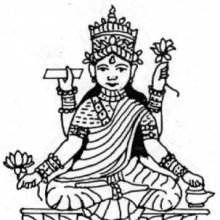Mahamanasi, Mahāmānasī, Maha-manasi: 5 definitions
Introduction:
Mahamanasi means something in Jainism, Prakrit, Hinduism, Sanskrit. If you want to know the exact meaning, history, etymology or English translation of this term then check out the descriptions on this page. Add your comment or reference to a book if you want to contribute to this summary article.
Images (photo gallery)
In Jainism
General definition (in Jainism)
Source: archive.org: The Jaina Iconography1) Mahāmānasī (महामानसी) or Nirvāṇī is the name of the Yakṣa accompanying Śāntinātha: the sixteenth of twenty-four Tīrthaṃkaras or Jinas, commonly depicted in Jaina iconography.—[...] Nirvāṇī in Śvetāmbara accounts, is represented as seated on a lotus and four-armed, the attributes being a book, lotus, Kamaṇḍalu and a lotus bud. The Digambara books supply descriptions of Mahāmānasī, according; to which, she has the vehicle of a peacock and holds in her hands a disc, fruit, Iḍi (sword?) and Varada.
The name Nirvāṇī connotes the idea of Nirvāṇa, llersyrn-bols of a book, lotus, Kamaṇḍalu strike one with her characteristic nature of the wife of Brahmā. Curiously, Brahmā’s wife is alsocalled Sarasvatī. As Mahāmānasī, the Yakṣiṇī holds her new function being a Vidyādevī. Mahāmānasī literally means the “great Goddess to preside over learning”. The symbol of a peacock, again, speaks of her connection with Sarasvatī, the river Goddess, who has the same bird as her riding vehicle..
2) Mahāmānasī (महामानसी) also refers to one of the sixteen Vidyādevīs (goddesses of learning).—The Śvetāmbaras describe the sixteenth Vidyādevī [viz., Mahāmānasī] as riding on a lion and bearing, in her four hands, Varada sword, kamaṇḍalu and lance. The Digambara representation of the goddess sits on a swan and holds a rosary, Varadamudrā, goad and garland. Again, the conception of this Vidyādevī is presumably based upon that of Vāgīśvarī, The sword symbol specially corresponding to the Digambara Yakṣiṇī of like name is Nirvāṇī of Jina Śāntinātha. As noticed before, her symbols of book, kamaṇḍalu and lotus befit more a Vidyādevī than a Yakṣiṇī. The Digambara conception of Mahāmānasī either as a Yakṣiṇī or Vidyādevī has symbols such as, peacock, swan, rosary, which fit in with the characteristics of the goddess of learning.

Jainism is an Indian religion of Dharma whose doctrine revolves around harmlessness (ahimsa) towards every living being. The two major branches (Digambara and Svetambara) of Jainism stimulate self-control (or, shramana, ‘self-reliance’) and spiritual development through a path of peace for the soul to progess to the ultimate goal.
Languages of India and abroad
Sanskrit dictionary
Source: DDSA: The practical Sanskrit-English dictionaryMahāmānasī (महामानसी).—Name of a Jain goddess.
Mahāmānasī is a Sanskrit compound consisting of the terms mahā and mānasī (मानसी).
Source: Cologne Digital Sanskrit Dictionaries: Shabda-Sagara Sanskrit-English DictionaryMahāmānasī (महामानसी).—f. (-sī) A goddess peculiar to the Jainas.
Source: Cologne Digital Sanskrit Dictionaries: Monier-Williams Sanskrit-English DictionaryMahāmānasī (महामानसी):—[=mahā-mānasī] [from mahā > mah] f. a goddess peculiar to the Jainas, [cf. Lexicographers, esp. such as amarasiṃha, halāyudha, hemacandra, etc.]
Source: Cologne Digital Sanskrit Dictionaries: Yates Sanskrit-English DictionaryMahāmānasī (महामानसी):—[mahā-mānasī] (mī) 3. f. A goddess peculiar to the Jainas.
Sanskrit, also spelled संस्कृतम् (saṃskṛtam), is an ancient language of India commonly seen as the grandmother of the Indo-European language family (even English!). Closely allied with Prakrit and Pali, Sanskrit is more exhaustive in both grammar and terms and has the most extensive collection of literature in the world, greatly surpassing its sister-languages Greek and Latin.
See also (Relevant definitions)
Partial matches: Maha, Manasi.
Starts with: Mahamanasika.
Full-text: Nirvani, Kimpurusha, Vidyadevi, Garuda, Shantinatha, Purushadatta.
Relevant text
Search found 4 books and stories containing Mahamanasi, Mahāmānasī, Maha-manasi, Mahā-mānasī; (plurals include: Mahamanasis, Mahāmānasīs, manasis, mānasīs). You can also click to the full overview containing English textual excerpts. Below are direct links for the most relevant articles:
Jainism in Odisha (Orissa) (by Ashis Ranjan Sahoo)
Jaina Antiquities in Martasol (Balasore) < [Chapter 3: Survey of Jaina Antiquities in Odisha]
Santinatha image at Akhandalesvara Temple, Jajpur Town < [Chapter 3: Survey of Jaina Antiquities in Odisha]
Santinatha image at Amrutesvara Temple, Tala Beguniapada < [Chapter 3: Survey of Jaina Antiquities in Odisha]
Jain Remains of Ancient Bengal (by Shubha Majumder)
Caubisi type of Śāntinātha Sculpture < [Chapter 6 - Iconographic Study of Jaina Sculptural Remains]
Images of Tīrthaṅkara Śāntinātha (Introduction) < [Chapter 6 - Iconographic Study of Jaina Sculptural Remains]
A study of the philosophy of Jainism (by Deepa Baruah)
Chapter I.c - The lives of the Tīrthaṅkaras < [Chapter I - Introduction]
Saraswati < [Aug - Sept 1939]
